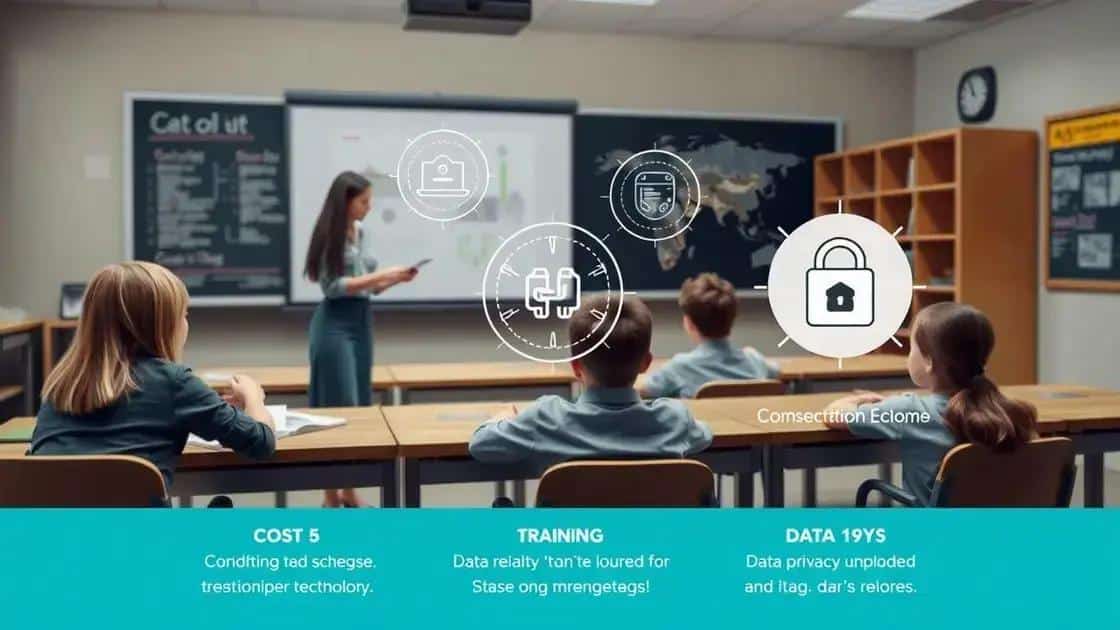AI in classrooms trends: the future of education

AI in classrooms enhances personalized learning, improves engagement, streamlines administrative tasks, and enables real-time feedback, though it faces challenges such as cost, training needs, and data privacy concerns.
AI in classrooms trends are transforming the educational landscape, impacting how students learn and teachers instruct. Have you ever wondered how these advancements could change your classroom experience? Let’s dive deeper into the subject.
The role of AI in enhancing learning experiences
Understanding the role of AI in enhancing learning experiences is essential in today’s educational landscape. AI technologies are not just tools; they are becoming integral to classroom dynamics.
Personalized Learning
One of the most exciting aspects of AI is its ability to provide personalized learning experiences. Programs can adapt to each student’s learning pace, helping them grasp complex concepts more effectively.
Improving Engagement
AI can make lessons more interactive and fun. Using chatbots or virtual assistants, students can engage with lessons in real time, getting instant feedback that keeps them motivated.
- Interactive quizzes driven by AI
- Gamification of lessons
- Real-time feedback systems
These features can transform how students participate in their education. Furthermore, by analyzing learning patterns, AI can help teachers identify areas where students may struggle, allowing for targeted interventions.
Efficiency in Administration
AI also enhances efficiency in administrative tasks. From grading assignments to scheduling, these tasks can be automated. This time-saving feature allows teachers to focus more on their students and less on paperwork.
The integration of AI in classrooms does not eliminate the need for human interaction; instead, it enhances the educational experience. By leveraging technology, classrooms can foster an environment where students feel supported and understood.
Benefits of AI tools for educators

The benefits of AI tools for educators are numerous and transformative. These tools not only streamline teaching processes but also enhance the learning environment for students.
Time-Saving Automation
One of the primary advantages of AI is its ability to automate routine tasks. Educators can save significant time on grading, scheduling, and lesson planning, allowing more focus on teaching.
- Automated grading systems
- Scheduling assistance
- Resource management tools
This increased efficiency enables teachers to spend more time interacting with students, thus improving the overall educational experience.
Enhanced Learning Insights
AI tools also provide valuable insights through data analysis. With the help of these tools, educators can track student progress and identify areas needing improvement. This data-driven approach allows for the development of targeted interventions.
Additionally, AI can recommend unique resources tailored to each student’s learning style. By understanding how students learn best, teachers can personalize their instruction more effectively.
Professional Development Opportunities
AI tools can assist educators in their own development as well. With platforms that offer tailored training programs based on individual needs, teachers can enhance their skills on a continuous basis.
- Access to online training modules
- Peer collaboration tools
- Feedback systems for improvement
This focus on professional growth ultimately leads to better outcomes for both educators and students. The integration of AI in the classroom promotes a culture of continuous learning, fostering a dynamic and engaging educational environment.
How AI personalizes student learning
Understanding how AI personalizes student learning is crucial in adapting to new educational environments. AI technology can cater to individual needs, enhancing the learning experience for each student.
Tailored Learning Paths
AI systems analyze student performance and preferences, allowing them to create tailored learning paths. This personalized approach enables students to progress at their own pace.
- Customized lesson plans based on strengths and weaknesses
- Real-time adjustments to learning activities
- Enhanced engagement through relevant content
By receiving instruction that aligns with their unique learning styles, students become more motivated and invested in their education.
Continuous Feedback Mechanisms
AI also facilitates continuous feedback, providing students and teachers with instant insights. This immediate response helps identify areas that require further attention.
For instance, if a student struggles with a particular topic, AI can suggest additional resources or alternative methods of learning. Such adaptability is essential for cultivating a supportive learning environment.
Adaptive Assessments
Another key feature of AI in education is adaptive assessments. These assessments adjust in complexity based on the student’s performance. This approach ensures that students are challenged appropriately, fostering growth without overwhelming them.
- Dynamic quizzes tailored in real-time
- Immediate identification of learning gaps
- Opportunities for mastery at each step
By utilizing AI to personalize learning experiences, educators can foster a more productive and engaging environment. This ultimately leads to improved outcomes and a deeper understanding of concepts.
Challenges of implementing AI in classrooms

Understanding the challenges of implementing AI in classrooms is vital for educators and administrators. While AI offers many benefits, there are significant hurdles to consider.
Cost and Resource Allocation
One of the first challenges involves the costs associated with AI technology. Schools often have tight budgets, making it difficult to invest in the latest tools. Without adequate funding, implementing AI can become a daunting task.
- High initial investment for software and hardware
- Ongoing maintenance and support expenses
- Training costs for teachers
Balancing these expenses with other educational needs is essential for successful integration.
Training and Support for Educators
Another obstacle is ensuring teachers receive proper training. Many educators may feel unprepared or overwhelmed by new technology. Providing comprehensive training programs is crucial to help them adapt to AI tools.
Teachers need support and ongoing professional development to feel confident using these technologies. It’s essential to create a culture that encourages learning and exploration.
Data Privacy and Security Concerns
Data privacy is a significant concern when using AI in the classroom. Schools handle sensitive information about students, and any breach can lead to serious consequences. Ensuring data protection measures are in place is critical to maintaining trust.
- Compliance with regulations and laws
- Risk of data breaches affecting student information
- Transparency in data usage and storage
Establishing clear policies and practices around data security can help mitigate these risks.
Lastly, the integration of AI may face resistance from parents and the community. Addressing their concerns and demonstrating the benefits of AI in education can pave the way for smoother adoption.
FAQ – Frequently Asked Questions about AI in Classrooms
What are the key benefits of AI in education?
AI enhances personalized learning, provides real-time feedback, and streamlines administrative tasks, improving overall teaching efficiency.
What challenges do schools face when implementing AI?
Challenges include high costs, the need for teacher training, data privacy concerns, and gaining community support.
How does AI personalize the learning experience for students?
AI analyzes student data to create tailored learning paths, ensuring each student can learn at their own pace and style.
What role does teacher training play in successful AI integration?
Comprehensive teacher training is essential to ensure educators feel equipped to utilize AI tools effectively, maximizing their impact on student learning.






